Guide to Hardwood Floor Repair
May 6, 2024 | By Bruce Product Expert
Some flooring repairs are a simple DIY task, mainly scratches and minor gouges in the flooring. Other wood floor repairs, however, may require professional help, especially for replacement boards and substantial water damage.
In this guide, we’ll explore how to repair hardwood floors. So you have the knowledge and confidence to restore your floors to their former glory.
How Extensive is the Repair?
Before embarking on any repair project, assess the extent of the damage. Inspect your hardwood floors carefully, identifying scratches, dents, stains, or signs of warping.
Equally important, you should assess the cause of the damage. In some instances, the assessment will be simple. For example, your dog quickly stopped and dug his nails into your solid hardwood flooring.
In other cases, you might have to search for the cause. And that could point to more involved issues like structural concerns, water leaks, or temperature fluctuations.
Evaluating the damage will help determine whether you can undertake the repairs yourself or if hiring a professional is necessary.
Repairing Minor Surface Imperfections
The repair process is relatively straightforward for minor scratches, gouges, and small dents. Start by cleaning the damaged area to remove dirt and debris. Next, apply wood filler to the damaged spot and level it carefully using a putty knife.
Once the filler has dried, use sandpaper to smooth the repaired area. Finally, apply stain and finish to match the surrounding floor, achieving a seamless repair.
Read this blog to learn more about how to fix scratches on hardwood flooring.
Dealing with Warping and Buckling
Warping and buckling are common issues caused by moisture, humidity, or subfloor problems. Sanding and refinishing the affected area might be sufficient to address minor warping. However, significant warping requires more extensive repairs.
Begin by identifying and correcting the underlying cause of the warping, such as addressing moisture issues or subfloor concerns. Next, replace the damaged boards, ensuring they are level with the rest of the floor. Sand the repaired area to achieve a smooth surface and apply stain and finish for a cohesive appearance.
We’ll give you more details on replacing damaged floorboards in a minute.
How to Fix Water-Damaged Wood Floors
Solid hardwood floors can take punishment from many sources. But one form of punishment it can’t handle is water, especially prolonged exposure.
So, if you know an area may be subject to moisture concerns, look into other flooring options. Even engineered hardwood flooring can withstand moisture better than solid hardwood.
But if the worst happens, there are steps you can take to salvage water-damaged wood flooring.
1. Remove Standing Water: Remove standing water on the wood floor promptly to prevent further damage. Use towels, mops, or a wet-dry vacuum to soak up as much water as possible. Ensure the affected area is completely dry before proceeding.
2. Dry the Area: Properly drying the water-damaged wood floor prevents mold and further structural damage. Increase air circulation by opening windows, running fans, or using dehumidifiers. Use specialized equipment like floor dryers or moisture meters to ensure thorough drying. Allow sufficient time for the affected area to dry completely before proceeding with the repairs.
3. Inspect for Mold: Water damage often leads to mold growth, especially if you don’t dry the area quickly. So inspect the affected wood floor for any signs of mold or mildew. If you notice mold, it’s essential to address it promptly. You can contact a professional mold service to ensure safe and thorough removal.
4. Sanding and Refinishing: You must sand and refinish the damaged area if it’s discolored or warped.
Sand the floor and affected area, gradually working to a smooth and even surface. Pay attention to blending the repaired area with the surrounding floor. Once the sanding is complete, apply a suitable wood stain to match the original color. Finally, apply a protective finish to restore the shine and protect the wood from future damage.
Repairing Damaged Floorboards
In some instances, you may need to replace damaged floorboards. That’s often the case with water damage or the aforementioned warping and buckling.
Even excessive wear and tear may require replacing a section of your hardwood. In a worst-case scenario, you might even need to install hardwood floors entirely.
In any event, you’ll need to start by cutting out the damaged floorboards. You can use a pry bar, sharp chisel, or oscillating saws to remove the affected areas.
Replacement boards are where you can run into some issues. That’s because you’ll have to match the new floorboards with existing ones. And that’s sometimes the more substantial challenge, depending on the type of hardwood flooring and grain pattern.
It can be a delicate process of staining and finishing the new floorboards to an exact match. The last thing you want to do is sand and refinish the entire floor. That’s why purchasing more flooring than you need during installation is always a good idea.
Installing the Replacement Board
After you’ve successfully removed the damaged sections, take these steps to install the replacements.
1. Cut each replacement floorboard to length, removing the lower shoulder of the groove if necessary.
2. Tap the replacement into place, protecting it with a wood scrap.
3. Drill pilot holes for finishing nails to fasten the floorboard and use a nailset to sink the nail.
4. Once the new boards are in place, sand the repaired area to create a uniform surface.
5. Finally, apply stain and finish to blend the repaired section with the rest of the floor.
If you run into issues, you might want to contact a local contractor experienced with wood floor repairs.
Bruce is a Trusted Source for Hardwood Flooring
If you have additional questions, check out our website for answers to the most frequently asked questions. We’ve provided hardwood solutions to contractors and DIY enthusiasts for nearly 150 years.

Ready to shop for hardwood flooring near you?
Use our retail locator to find where you can buy Bruce oak flooring.
Find a Store
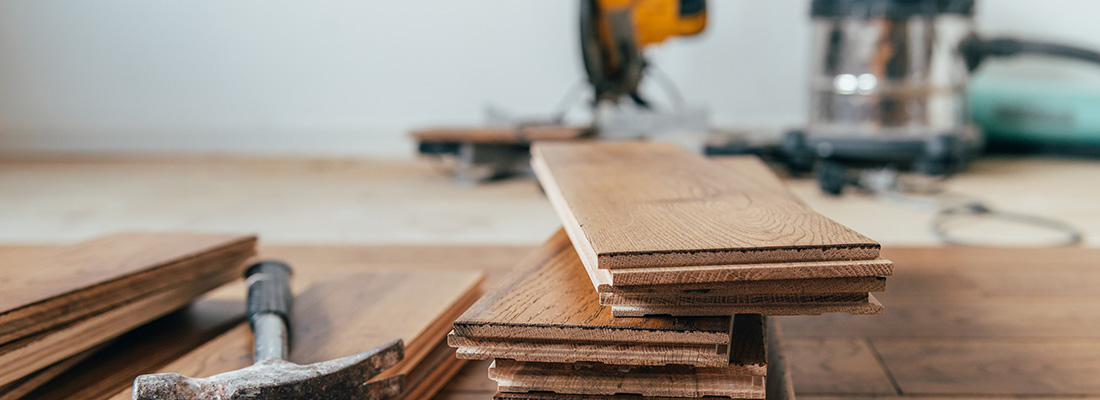
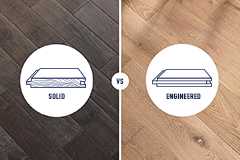 Solid vs Engineered Hardwood Flooring
Solid vs Engineered Hardwood Flooring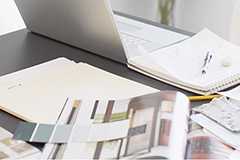 Guide To Choosing a Hardwood Floor
Guide To Choosing a Hardwood Floor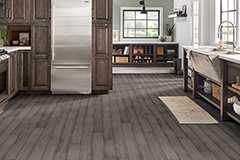 Hardwood Flooring Room Inspiration Guide
Hardwood Flooring Room Inspiration Guide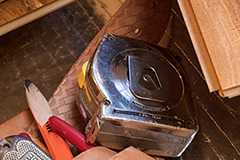 10 Things to Know About Hardwood Floor Installation
10 Things to Know About Hardwood Floor Installation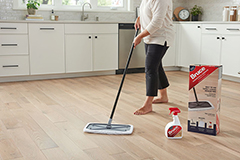 How To Clean and Protect Hardwood Flooring
How To Clean and Protect Hardwood Flooring